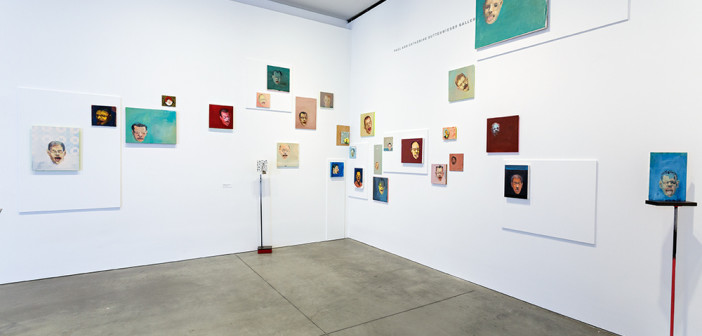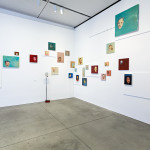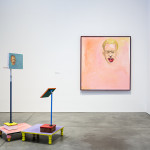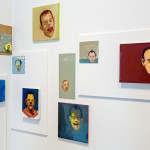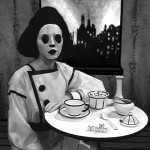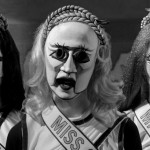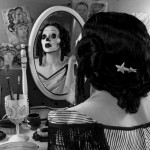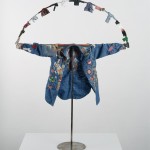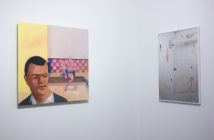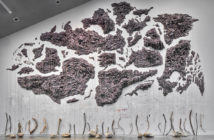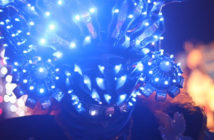It’s been a long time coming, but the ICA is beginning to show its true colors. The last few years have seen solo exhibitions by a strong number of female artists, a great many queer artists and people of color, reaching a high note with last year’s very gay, very feminist, ultimately historicizing exhibition This Will Have Been. The museum’s current offerings are bringing us back to the present, with Boston-based painter and educator Steve Locke’s There is No One Left to Blame alongside Mary Reid Kelley’s videos, and more recently, Amy Sillman’s one lump or two. The shows paint a broad picture of how art today fuses the personal to the social, with a deep investment in queer and feminist ideas. Over the last few years, we’ve seen an increasingly focused curatorial perspective from the ICA toward these issues. It’s an opportunity for the public to get an education on a diversity of social perspectives, and is a win for the institution.
This situation poses two main questions. First, what is the museum’s responsibility in addressing the social contexts of art being exhibited? Second, to what extent does an artist’s identity, presentation or social background influence a reading of their work? Both are more nuanced queries than can be answered here. However, considering the trends in the ICA’s recent programming, an assessment of the institution’s motives is necessary.
The ICA’s queer agenda (if you want to go so far) began quietly enough in 2010 with the restrained, even taciturn Roni Horn, who I deeply admire for the sophistication of her aesthetic vocabulary as well as her ability to maintain integrity across media. Horn is an artist for whom gender and sexuality are at once centrally fixed and off the table as a subject. The exhibition catalogue and wall text seemed to toe a line of disclosure of both the artist’s gender and orientation, avoiding gendered pronouns and often using indirect language around the issue of sexuality, which, knowing her work, may well have been the artist’s idea. But this coded relationship to the artist’s identity became problematic when it carried over to exhibitions of work by Mark Bradford, Charles Ledray, Isaac Julien, Mickalene Thomas, and Jeffrey Gibson that followed Roni Horn aka Roni Horn. All of these artists are queer people of color, each dealing by degrees with the problems of identification and presentation of othered people via the dominant conventions of visual culture. These artists also make work that is visually rich to the point of being entertaining. The ICA certainly brought in crowds with the latter quality, but to what extent did it attempt to educate visitors on the subtler problem of the former?
Christopher Bedford, Rose Art Museum director and curator of Mark Bradford’s 2010 exhibition, has described this marriage of pure visuality with social concerns as social abstraction, wherein "image is fused with context." He was speaking specifically to Bradford’s work, but hinted at a larger growing trend among artists today. This is perhaps the lens through which we can view the ICA’s recent spate of shows, up to the current exhibitions of Steve Locke and Mary Reid Kelley. How do artists, particularly those who fall into marginalized camps socially, create a body of work that is engaged with social realities while remaining rooted in a personally defined vocabulary? I think the basis of this question is a problem that most conscious artists face today, as it concerns the relationship between the self as artist and the self as citizen. And it’s a clear pre-occupation of both Steve Locke and Mary Reid Kelley.
Locke and Kelley’s exhibitions are very different from each other, but strike an exciting resonance. Both shows interrogate gender through hobbled performing subjects — in the case of Locke, disembodied portraits of men, and for Kelley, cleverly twisted historical tableaus, often featuring the artist herself in theatrical paint and costumes. Kelley’s videos are remarkably weighted with historical references for how buoyant they feel. Her use of rhyme schemes, puns and obscure references probe the various levels of language, from its most cerebral to its most bodily. Although relatively new to video, Kelley is a masterful storyteller, with an intense, almost obsessive desire to retell history through the lens of those who didn’t write the textbooks: French prostitutes, British factory workers, or even the Cretan Minotaur. On its own, her work warrants a deeper reading than can be made here. At the moment, I’m more interested in what this work can tell us in connection to Locke’s, and in regards to the larger curatorial program.

Mary Reid Kelley with Patrick Kelley. Priapus Agonistes, 2013. HD Video, Sound (still). Courtesy of the artist, Fredericks & Freiser Gallery, Susanne Vielmetter Los Angeles Projects, and Pilar Corrias, London
There are a number of formal relationships one can make between the two shows. Masks are a parallel theme, quite literally through Kelley’s made-up harlequins and through Locke’s evasive caricatures. Both are clearly interested in art history, and the history of representations. And then there are specifics that border on coincidental: Kelley’s interest in Medusa who, according to a sketchbook displayed amongst other source material for her videos, represents "impotence, voyeurism, the gaze deadly to men." These are the very issues that are loaded into Locke’s floating, painted heads, for which Carravagio’s Medusa is a noted influence.
Like Kelley, Locke is concerned with a gaze that is queered, flipped and conflated. His subjects are often wall-eyed and avoidant, resisting a direct connection to the viewer. Perched at odd angles, sometimes on metal armatures, they are sumptuously painted to invite a long, scrutinizing gaze, yet cannot gaze back. These depictions are of men who can be observed from a place of advantage or privilege. They are undermined in their representation, which allows us to view them with sensitivity, even pity, which is rarely afforded to contemporary images of men. And, of course, there are the tongues, lolling stupidly out of the subjects’ mouths. At once funny and disturbing, this recurring device perfectly situates Locke’s portraits within a negotiation of power between individuals, the history of portraiture (think the proto-feminist depictions of Judith and Holofernes), and the violence and indifference present in mediated culture.
It’s highly rewarding to see a local artist’s work progress through the gallery system and into the museum. The show is well timed for Locke’s work, which has developed depth of skill and a broadness of considerations traditionally beyond painting. Certain newer elements like painted edges, which give some works a fluorescent aura, and sculptural armatures thrusting the faces out at odd angles, have matured from awkward, tacked-on appendages to an otherwise strong painting practice into well-considered, almost necessary elements in Locke’s vocabulary. These accessories to the canvas (meant in the conspiratorial sense, not the trivializing material sense) create a hierarchy of spaces outside the painting: the wall, the edge and surrounding space, the gallery itself. They expand the painted subjects’ engagement with one another, the space, and importantly with the viewer. Formal considerations become entwined with social considerations. In the show, there are favorable places to stand in the space much in the same way there are good spots in a crowded bar or a party.
A few weeks ago, in conversation with curator and Fire Island Artist Residency co-founder Evan Garza at the ICA, Locke described what this sensation means for him personally. When someone described the show as a sort of off-kilter gathering, he responded that, "it’s like being at a party where all your friends are dead. And that’s what it’s like to be a gay man in your fifties. I didn’t come here alone. Everyone who is supposed to be with you is dead." Here the title piece of the show, which at first seems out of place in glowing neon, takes on a new meaning. There is no one left to blame when there is no one left but oneself.
But arguably, the title holds a double meaning. There is the elegiac sense of being the last man standing, quite literally; the sense of loss and loneliness left by the 1980s plague that devastated his community. Then there is the call to personal responsibility in present crises. "The stupid artist thing is over," Locke said in his conversation with Garza. We face the legacy of the Culture Wars in a Congressional standstill, as well as the battle for women’s rights. We face global problems in American militarism and impending environmental collapse. In spite of the insurmountable, the artist still has to go to work in the studio, and curators still need to put shows together. Locke was influenced by his mother’s definition of the artist’s role. "God made the artist to show people things they need to see." Simple, but what could be more political, more radically crucial than this?

Installation view of Steve Locke: there is no one left to blame at the Institute of Contemporary Art/Boston. Photo: John Kennard.
Locke and Garza started their conversation by talking about the Detroit Institute of Art and the artist’s hometown. For Locke, The DIA was a source of inspiration and a possibility for a life beyond his immediate environment. Toward the end of their talk, the conversation turned again to the museum’s role in the early development of a individual’s sense of self, as the two discussed the historicization of Robert Rauschenberg and Jasper Johns, and their closeting by historians and museum curators. In Rauschenberg and Johns’s shared influences, their coded messages to each other embedded across many works, there was a window, according to Garza, a narrow opportunity to expose the public to the interior life of a gay couple. This potentially radical position is one that many curators have failed to explore. Locke’s call to personal responsibility, to an acknowledgement of one’s place in the world and in a local community speaks to the impetus of such a message. If an artist’s role is to "show people what they need to see," it’s the curator’s role to facilitate that encounter, to open it up to a wider audience, and to provide context to the artist’s personal language. It means going beyond a hermetic relationship to the artists’ practices, ensuring that their ideas "touch ground" and make contact with the people who could most benefit from them. What the ICA has done by consistently showing work of often-marginalized members of society is fantastic. What they still can do by addressing these contexts in a way that is accessible to a broad audience is where the institution can make history.
There’s no indication that the ICA is slowing down in its programmatic vision. The first-ever survey of Amy Sillman’s work balances her large abstract paintings with intimate drawings and zines that portray an earnest struggle for community and self-worth (more on this in Leah Triplett’s review). In November, the museum will show the brilliant LaToya Ruby Frazier, whose photographs of Braddock, Pennsylvania marry social documentary to a deep intimacy, and a survey of the late Chicago-based feminist painter Christina Ramberg. These are two artists who tackle their subject matter head-on, confronting, gender, class and race in explicit terms. How the museum represents both artists’ work will be worth watching.
- Installation view of Steve Locke: there is no one left to blame at the Institute of Contemporary Art/Boston. Photo: John Kennard.
- Installation view of Steve Locke: there is no one left to blame at the Institute of Contemporary Art/Boston. Photo: John Kennard.
- Installation view of Steve Locke: there is no one left to blame at the Institute of Contemporary Art/Boston. Photo: John Kennard.
- Mary Reid Kelley, Sadie the Saddest Sadist, 2009 HD Video, Sound (still). Courtesy of the artist, Fredericks & Freiser Gallery, Susanne Vielmetter Los Angeles Projects, and Pilar Corrias, London
- Mary Reid Kelley with Patrick Kelley. Priapus Agonistes, 2013. HD Video, Sound (still). Courtesy of the artist, Fredericks & Freiser Gallery, Susanne Vielmetter Los Angeles Projects, and Pilar Corrias, London
- Mary Reid Kelley with Patrick Kelley. The Syphilis of Sisyphus, 2011 (still). HD video, sound. Courtesy of the artist, Fredericks & Freiser Gallery, Susanne Vielmetter Los Angeles Projects, and Pilar Corrias, London
- Charles LeDray. Come Together (1995-1996). Thread, embroidery floss, and steel, 34 1/2 in. x 26 in. x 6 1/2 in. San Francisco Museum of Modern Art. Purchase through a gift of Kimberly S. Light. © Charles LeDray.

